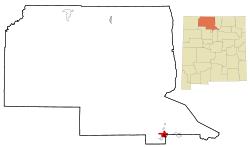Española, New Mexico
| Española | ||
|---|---|---|
| City | ||

Skyline view from the city's Industrial Park
|
||
|
||
| Motto: The heart of northern New Mexico…where cultures unite. | ||
 Location of Española, New Mexico |
||
| Location in the United States | ||
| Coordinates: 36°0′7″N 106°3′53″W / 36.00194°N 106.06472°WCoordinates: 36°0′7″N 106°3′53″W / 36.00194°N 106.06472°W | ||
| Country | United States | |
| State | New Mexico | |
| County | Rio Arriba, Santa Fe | |
| Founded | 1880 | |
| Incorporated | 1925 | |
| Named for | See history section | |
| Government | ||
| • Type | Mayor-council government | |
| • Mayor | Alice Alarid–Lucero | |
| • City Council |
Councilors
|
|
| • State House |
Representatives
|
|
| • State Senate |
State senators
|
|
| • U.S. House |
Representative
|
|
| Area | ||
| • Total | 8.5 sq mi (21.9 km2) | |
| • Land | 8.4 sq mi (21.7 km2) | |
| • Water | 0.08 sq mi (0.2 km2) | |
| Population (2010) | ||
| • Total | 10,495 | |
| • Density | 1,140/sq mi (440.0/km2) | |
| ZIP codes | 87532, 87533 | |
| Area code(s) | 505 | |
| FIPS code | 35-25170 | |
| GNIS feature ID | 928729 | |
| Website | Official website | |
| Largest Employers in Española | |
|---|---|
| 1 | Los Alamos National Laboratory |
| 2 | Española Public Schools |
| 3 | Espanola Presbyterian Hopsital |
| 4 | Akal Security, Inc. |
| 5 | Northern New Mexico College |
| 6 | Northern Pueblos Gaming Council |
| 7 | Walmart |
| 8 | Lowe's Home Improvement |
| 9 | Española City Government |
| 10 | Rio Arriba County |
Española /ɛspənˈjoʊlə/ is a city primarily in Rio Arriba County, New Mexico, in the United States. A portion of the central and eastern section of the city is in Santa Fe County. Española was founded in 1880 as a railroad village and incorporated as a city in 1925. The city is situated in an area Juan de Oñate declared a capital for Spain in 1598. Española has been called the first capital city in America. At the 2010 census, the city had a total population of 10,495. Española is within the Albuquerque – Santa Fe – Las Vegas combined statistical area.
Española was referred to as La Vega de los Vigiles (Vigil's Meadow) before the presence of railroads. It is believed that the town that began as Española was named by railroad workers. At the time of railroad construction, a small restaurant in the area was nicknamed "La Española". This was because of the large presence of Spanish women in the area. The name became official by 1900 and Española became a small railroad town. Before the railroads, this is where Spanish and Native American people had settled for hundreds of years, making a living from farming along the Rio Grande.
The Española area (known as the "San Juan Valley" to the early Spaniards) is also known as the first European-founded capital of the "New World." The region was explored In 1598 by Don Juan de Oñate. He declared the area a capital for Spain, the area of Don Diego de Vargas' new villa at Santa Cruz. Oñate arrived in the Española area on July 11, 1598, at the confluence of the Chama River and the Rio Grande, where he established a camp at a place then called Yunque-Yunque. He created a Spanish settlement in an area already inhabited by the indigenous descendants of the Anasazi.
...
Wikipedia


